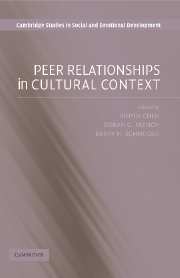Book contents
- Frontmatter
- Contents
- List of Contributors
- Introduction
- Part I Culture and Peer Relationships: Theoretical and Methodological Issues
- 2 Children's Social Behaviors and Peer Interactions in Diverse Cultures
- 3 Cultural Influences on Peer Relations: An Ecological Perspective
- 4 Analytic Considerations in Cross-Cultural Research on Peer Relations
- 5 Qualitative Research on Children's Peer Relations in Cultural Context
- Part II Temperamental and Emotional Influences on Peer Relationships
- Part III Peers and Parents
- Part IV Peer Interactions and Social Behaviors
- Part V Friendships
- Author Index
- Subject Index
- References
5 - Qualitative Research on Children's Peer Relations in Cultural Context
from Part I - Culture and Peer Relationships: Theoretical and Methodological Issues
Published online by Cambridge University Press: 08 August 2009
- Frontmatter
- Contents
- List of Contributors
- Introduction
- Part I Culture and Peer Relationships: Theoretical and Methodological Issues
- 2 Children's Social Behaviors and Peer Interactions in Diverse Cultures
- 3 Cultural Influences on Peer Relations: An Ecological Perspective
- 4 Analytic Considerations in Cross-Cultural Research on Peer Relations
- 5 Qualitative Research on Children's Peer Relations in Cultural Context
- Part II Temperamental and Emotional Influences on Peer Relationships
- Part III Peers and Parents
- Part IV Peer Interactions and Social Behaviors
- Part V Friendships
- Author Index
- Subject Index
- References
Summary
Recently, we have seen important changes in the conceptualization of human development in psychology, sociology, and anthropology. In general, these changes involve a greater focus on children's agency, more concern for the importance of social and cultural context, and agreement that children's experiences beyond their early years in the family (especially their interactions and experiences with peers) are in need of more careful theoretical consideration and empirical research. Also, at least in sociology and anthropology, there is recognition that children both affect and are affected by society and culture. This recognition has increased the appreciation of the creativity and autonomy of children's peer cultures and the awareness that the nature and quality of children's lives, even in their first years, is enriched or constrained by power relations and social policies in the cultures in which they live (Corsaro & Fingerson, 2003).
Although some aspects of children's peer relations and cultures may be universal, the way these aspects are developed and manifested, and other features of children's cultures, are clearly affected by the larger cultural context in which they develop (Corsaro, 1988, 1994, 2005; Corsaro, Molinari, & Rosier, 2002). Therefore, in studying children's peer relations, it is necessary to take a comparative perspective and to attempt to identify how key processes in children's peer cultures both affect and are affected by the larger cultural structures and processes within which they are embedded.
- Type
- Chapter
- Information
- Peer Relationships in Cultural Context , pp. 96 - 120Publisher: Cambridge University PressPrint publication year: 2006
References
- 12
- Cited by

